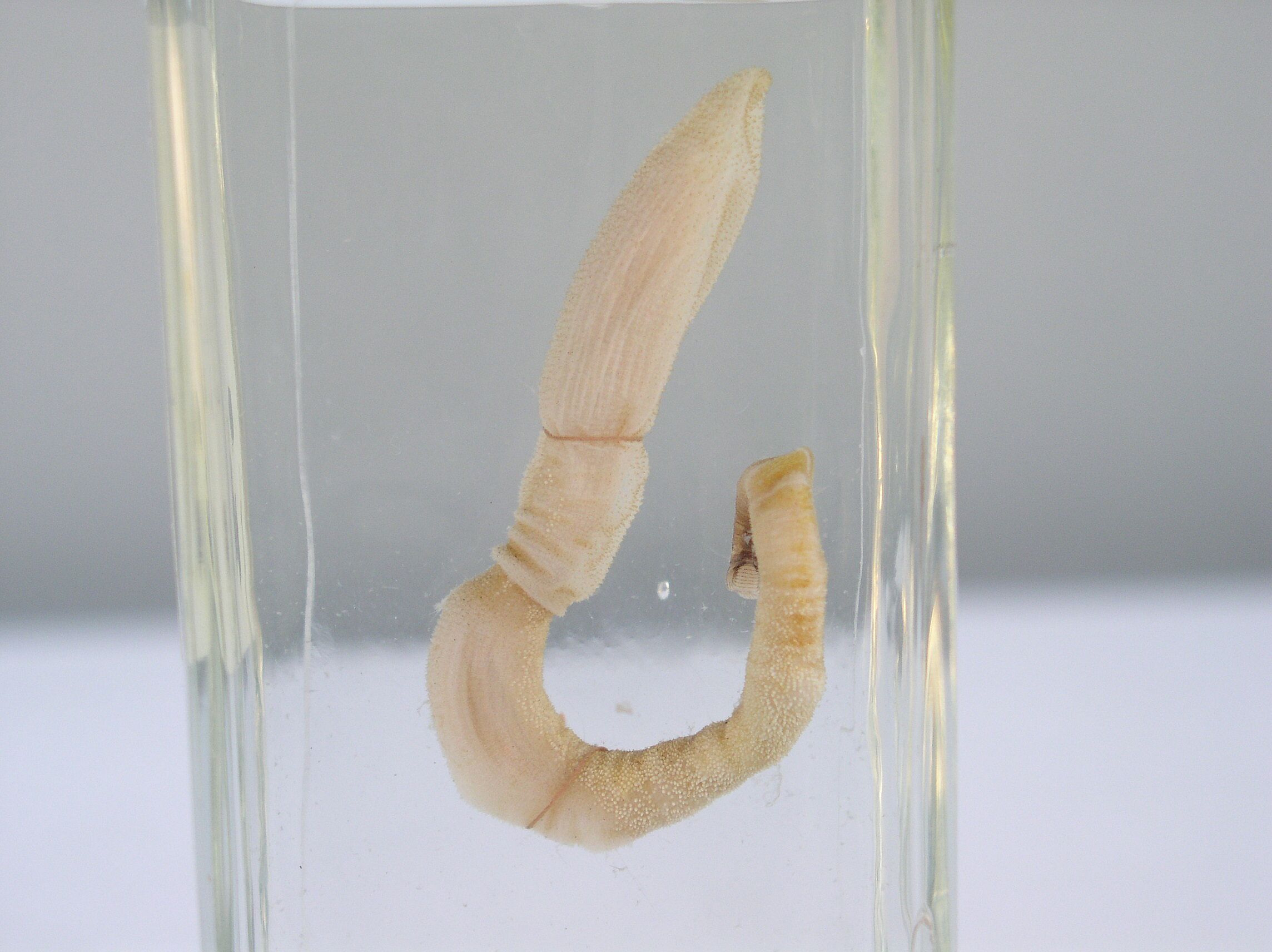- Acorn worm
name = Enteropneusta
regnum =Animal ia
phylum =Hemichordata
classis = Enteropneusta
subdivision_ranks = Families
subdivision =Harrimaniidae Protoglossidae Ptychoderidae Saxipendiidae Spengelidae Torquaratoridae The Acorn worms or Enteropneusta are a hemichordate class of
invertebrate s. Acorn worms are classified in the phylumHemichordata , closely related to thechordate s. There are about 70 species of acorn worm in the world, the main species for research being "Saccoglossus kowaleski".All species are infaunal
benthos that either may bedeposit feeder s orsuspension feeder s. Some of these worms may grow to be very long; one particular species may reach a length of 2.5 meters (almost eight feet), although most acorn worms are much, much smaller.One genus, "
Balanoglossus ", is also known as the tongueworm .Anatomy
The Acorn worm's body is cylindrical. The body is made up of three main parts: the acorn-shaped proboscis, a short fleshy collar that lies behind it, and the long trunk, which is the rest of the body. The creature's
mouth is located at the collar behind the proboscis. One theory is that this three-part body originates from an early common ancestor of all the deuterostomes, and maybe even from a common bilateral ancestor of both the deuterostomes and protostomes.The skin is covered with cilia as well as glands that secrete mucus. Some produce a bromide compound that gives them a medicinal smell and might protect them from bacteria and predators.
Acorn worms move by cilia movements and body contractions.
Acorn worms breathe by drawing in oxygenated water through their mouth. The water then flows out the animal's gills which are on its trunk. Thus, the acorn worm breathes about the same way as fish.
imilarities to chordates
Acorn worms are considered more highly specialised and advanced than other similarly shaped worm-like creatures. They have a circulatory system with a heart that also functions as a kidney. Acorn worms have gill-like structures that they use for breathing, similar to the gills of primitive fish. Hence, acorn worms are sometimes said to be a link between classical invertebrates and vertebrates. Some also have a postanal tail which sometimes shows weak signs of segmentation. An interesting trait is that its three-section body plan is no longer present in the vertebrates, except for the anatomy of the frontal neural tube, later developed into a brain which is divided into three main parts. This means some of the original anatomy of the early chordate ancestors is still present even if it is not always visible.
Lifestyle
Acorn worms are rarely seen by humans because of their lifestyle. They live in U-shaped burrows on the sea-bed, from the shoreline down to a depth of 10,000 ft. (3,050 m). The worms lie there with the proboscis sticking out of one opening in the burrow. Acorn worms are generally slow burrowers.
To obtain
food , many acorn worms swallow sand or mud that contains organic matter and microorganisms in the manner of earthworms (this is known as deposit feeding). At low tide, they stick out their rear ends at the surface and excrete coils of processed sediments (casts).Another method that some acorn worms use to obtain food is to collect suspended particles of organic matter and microbes from the water. This is known as suspension feeding.
Reproduction
Acorn worms have separate genders that release eggs and sperm into the water for external fertilization. In some, eggs develop into free-swimming larvae that look very similar to echinoderm larvae (this suggests vertebrates and echinoderms are closely linked phylogenically). The larvae eventually settle down and change into tiny acorn worms on the surface and take on the burrowing lifestyle. Others don't have a larval stage, but develops directly into small juveniles.
Wikimedia Foundation. 2010.

